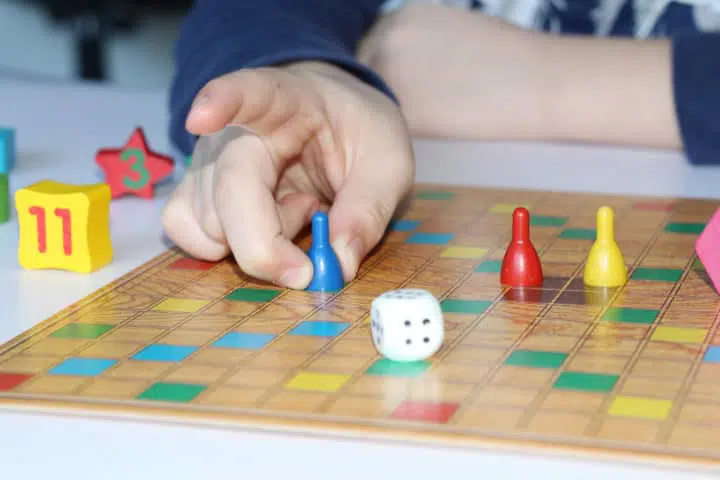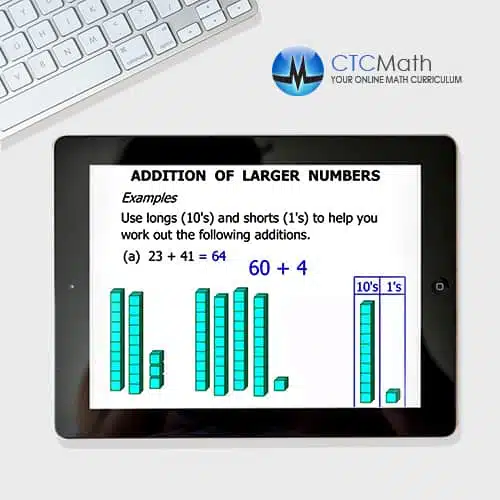7 Excellent Ways to Help Your Kid LOVE Math
Are you one of those people who is “bad at math”? Try these tips to avoid passing your negative feelings along to your kids and help them love math. And, learn how CTCMath can help!
7 Excellent Ways to Help Your Kid LOVE Math
Math is one of those subjects that seems to intimidate adults and children alike. We nurse our negative feelings about long-division or solving for x into adulthood. Then, whether consciously or unconsciously, we pass those negative feelings on to our kids.

Math shouldn’t seem so intimidating, though. We use it every day – often much more than we realize. Try these tips to overcome your negative feelings and help your kids learn to love math.
How to Help your Kid LOVE Math!
1. Don’t Trash-Talk Math
I know I can’t be the only mom who disliked math in school. I mean, addition and subtraction were fine. Multiplication drills started to kill the fun a bit. Then, there was long-division in sixth grade with Mrs. Compton. Mrs. Manuel, in seventh grade, put the nail in the coffin.
And don’t even get me started about algebra with Mrs. Boswell.
But your kids don’t have Mrs. Compton, Mrs. Manuel, or Mrs. Boswell. They have you! Your teachers may not have had time to spend one-on-one with you making sure you understood and learned to love math, but your kid’s teacher does! (Hint: That’s you, Mom or Dad – or, you know, the instructor in the video.)
So, don’t pass along any lingering hostile math feelings. Your kids don’t need to hear phrases like:
- I was always terrible at math.
- I hated math when I was in school, too.
- Some people just aren’t good at math.
2. Read Math-Themed Books
We read engaging books about history and science. We use books to demonstrate the mechanics of written language. And, just about every baby has a book about numbers. Why abandon books about mathematical concepts after our kids learn to count to ten?
Instead, teach your kids number sense and encourage higher-level math thinking with books such as:
- Sir Cumference and the First Round Table
- The Grapes of Math
- What’s Your Angle, Pythagoras?
- Wild Fibonacci: Nature’s Secret Code Revealed

3. Play Games That Use Math
Play games that get kids counting, adding, subtracting, dividing, estimating, sequencing, and more. There are lots of games specifically designed to teach math concepts, but many of the classics rely on math as part of the gameplay. Often, that’s the best approach because it doesn’t put math into a separate (boring/confusing/complicated) category.
Try games like:

4. Let Kids Experience Math in Their Everyday Lives
No matter if you love math or have lingering negative feelings about the subject, we all use its concepts every day. Give your kids plenty of opportunities to experience math. (Tip: Don’t point the experiences out as math. Just let your kids explore.)
Do things like:
- Bake together – and double the recipe to share with a neighbor!
- Go shopping. Head to the clearance rack and let your kids figure out the sale price and add the sales tax.
- Let your kids pay for things. They can count out their money and make sure they receive the correct change.
- Need new carpet? Ask your kids to figure out how many square feet you’ll need.
- Hear the ice cream truck in your neighborhood? Grab the change jar and let them pick out the coins they’ll need.
- Go out to eat. Let your kids figure out how much to leave for the tip.
5. Teach Effective Strategies
One of the things that surprised me the most when it came time to help my kids with math was how many of the formulas I remembered. Area of a rectangle = length x width. Perimeter of a rectangle = 2length + 2width.
I probably wasn’t impressed at the time I was learning them, but all those formulas I stored in the back of my mind were incredibly useful.

Formulas aren’t the only types of effective strategies, though. You may need to look at entirely different approaches to teaching common math concepts. One of my children struggled with multiplying two- and three-digit numbers. Our discovery of the lattice multiplication method made a confusing concept simple for her.
Don’t be afraid to try different approaches to find the one that makes sense to your student.
6. Provide the Right Tools
When a child sits down to write an essay, we make sure he has tools such as a dictionary and a thesaurus. The right paper is important, too. You wouldn’t give a first-grader college-ruled paper.
We need to do the same for our students when it comes to math. Provide tools such as manipulatives for counting, adding, and subtracting; graph paper for keeping numbers lined up when adding, subtracting, multiplying, or dividing; or a graphing calculator for higher-level computations.
7. Choose the Right Curriculum
Homeschool math curriculum is not one-size-fits-all. One of home education’s greatest benefits is the freedom to use the best curriculum for each student and family situation. And one of the best ways to help your kid love math is to find the curriculum that makes it fun – for you and your student.

If the word “math” produces stress or tears at your house, consider trying CTCMath. It’s online math curriculum for students in grades K-12.
The benefits of CTCMath include:
Access to All Lessons
A CTCMath membership provides access to all lessons so kids can progress at their own pace. It’s okay to move ahead if they need to or go back and reteach the basics. Access to all the lessons and diagnostic tests makes CTCMath an excellent choice for providing remedial math support.
Control Over Each Lesson
Students can pause, fast-forward, or rewind each lesson. That means if they zone out and miss something (It happens to the best of us!), they can go back and watch that part again.
Great for Visual and Audio Learners
Concepts are broken up into short, engaging lessons that include audio and animation, so it’s great for all types of learners. The step-by-step explanations demonstrate concepts using both diagrams and mathematical notation. And, they focus on teaching math using traditional methods that make sense to parents and students alike.
There are also interactive questions to ensure understanding and worksheets for more practice.

Convenient
Because CTCMath is online, it’s convenient to access on desktop or mobile devices. Plus, the video tutorials make it easy for kids to use CTCMath independently, giving overloaded homeschooling parents more time to focus on other students and subjects.
Plus, with detailed reports for parents, you can always see where your child is and identify areas in which he may need additional practice.
Free Trial
If you’re worried that your child’s attitude toward math may be spiraling down to phobia, take advantage of the CTCMath free trial to see if the program is right for your student. If it turns out that CTCMath is a good fit, they offer competitive monthly and yearly subscription rates with a discount for multiple students.
So don’t share negativity about math with your kids. Use these tips – and CTCMath – to help your kids learn to love math!
You Might Also Like
Wendy is one of the owners of Hip Homeschool Moms, Only Passionate Curiosity, Homeschool Road Trips, Love These Recipes, and Weird, Unsocialized Homeschoolers. She married her high school sweetheart, Scott, 31 years ago, and they live in the South. They have three adult children. Hannah, age 27, has autism and was the first homeschool graduate in the family. Noah, age 25, was the second homeschool graduate and the first to leave the nest. Mary Grace, age 19, was the last homeschool graduate. Wendy loves working out and teaching Training for Warriors classes at her local gym. She also enjoys learning along with her family, educational travel, reading, and writing, and she attempts to grow a garden every summer with limited success. (But she's learning!)






